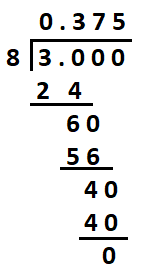
| Table 1 What should be easily recognizeable conversions | |||||||||||||||
| common fraction |
1
/
2
|
1
/
4
|
3
/
4
|
1
/
5
|
2
/
5
|
3
/
5
|
4
/
5
|
1
/
8
|
\
3
/
8
|
5
/
8
|
7
/
8
|
1
/
10
|
3
/
10
|
7
/
10
|
9
/
10
|
| decimal fractions |
0.5 | 0.25 | 0.75 | 0.2 | 0.4 | 0.6 | 0.8 | 0.125 | 0.375 | 0.625 | 0.875 | 0.1 | 0.3 | 0.7 | 0.9 |
| percents | 50% | 25% | 75% | 20% | 40% | 60% | 80% | 12.5% | 37.5% | 62.5% | 87.5% | 10% | 30% | 70% | 90% |



 button and select option 1,
button and select option 1,
 , and then press the
, and then press the  . The calculator
produces the fraction.
. The calculator
produces the fraction.


|
The most discerning readers will have noticed that all of the fractions shown above,
at least in their reduced versions, have denominators that have only 2 and/or 5 as
factors. This is not an accident. Fractions, in reduced form that have values other than
2 or 5 as factors of the denominator will be repeating decimal fractions.
For example,
1
/
3
= 0.3333
or
8
/
13
= 0.615384615384
or
3352
/
4625
= 0.724756756756
or
93
/
2860
= 0.03251748251748.
Converting repeating decimals to fractions takes a little algebra. This is more than we want to cover here. Our discussion here is limited to what are often called terminating decimals. That is, we will look at 0.1414 but not at 0.141414. We would need a different web page to demonstrate converting repeating decimals to fractions. |